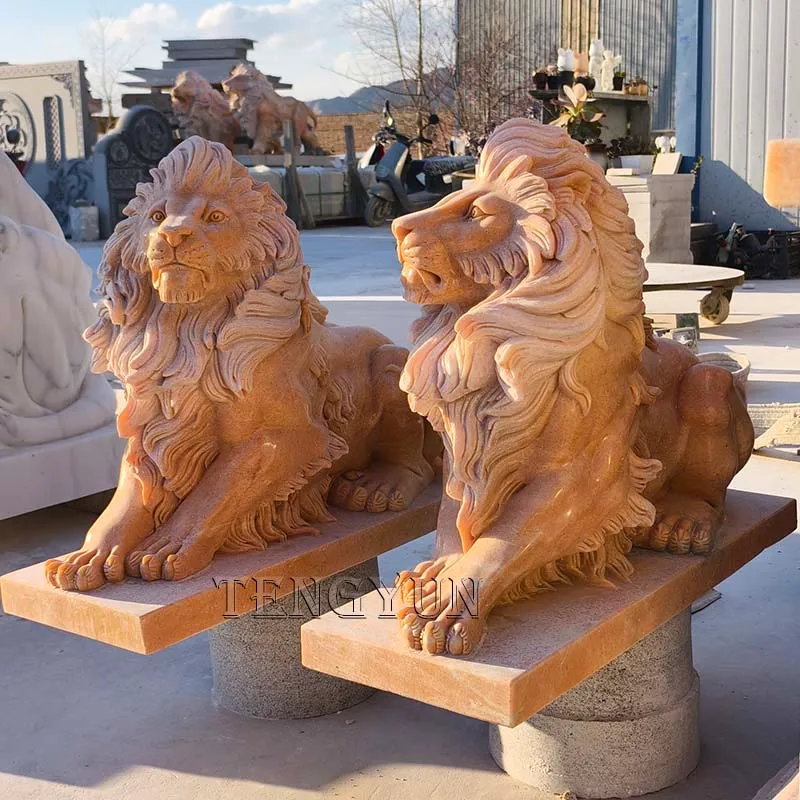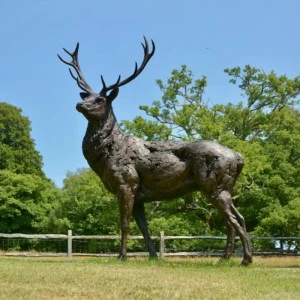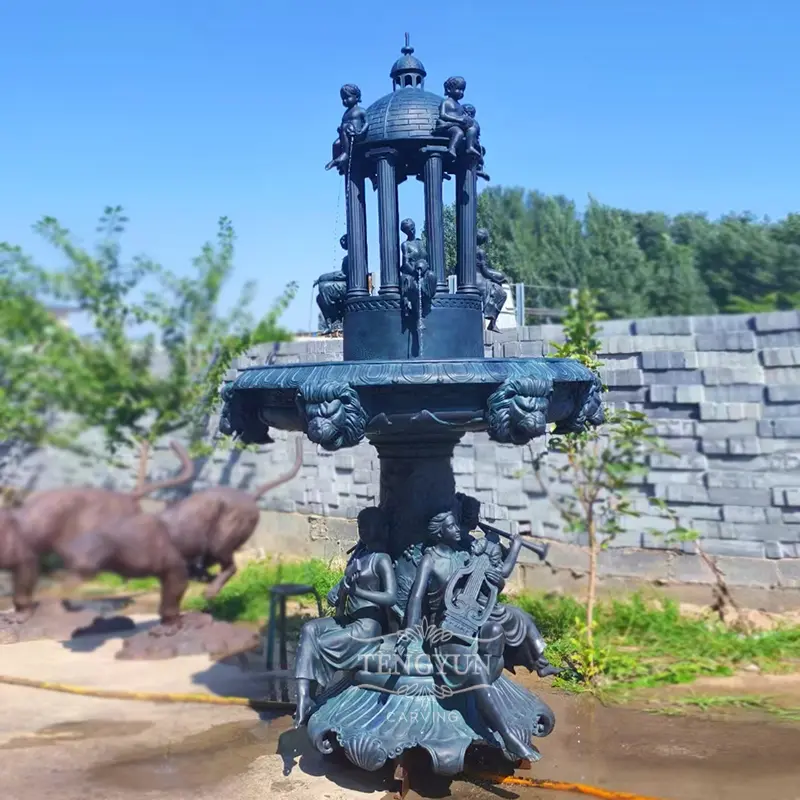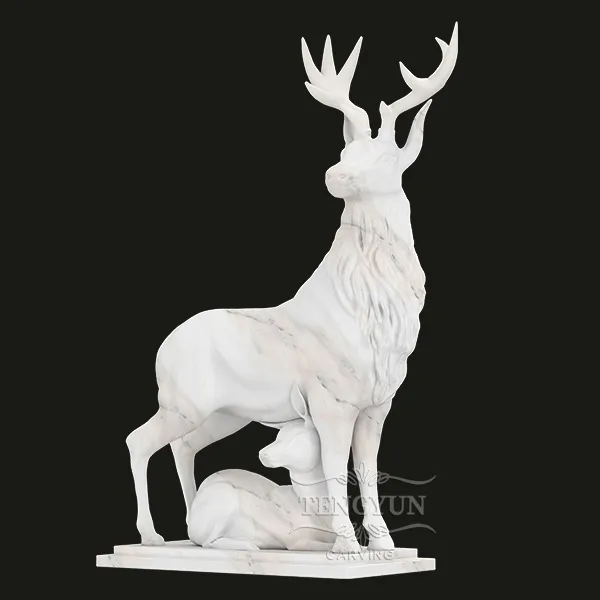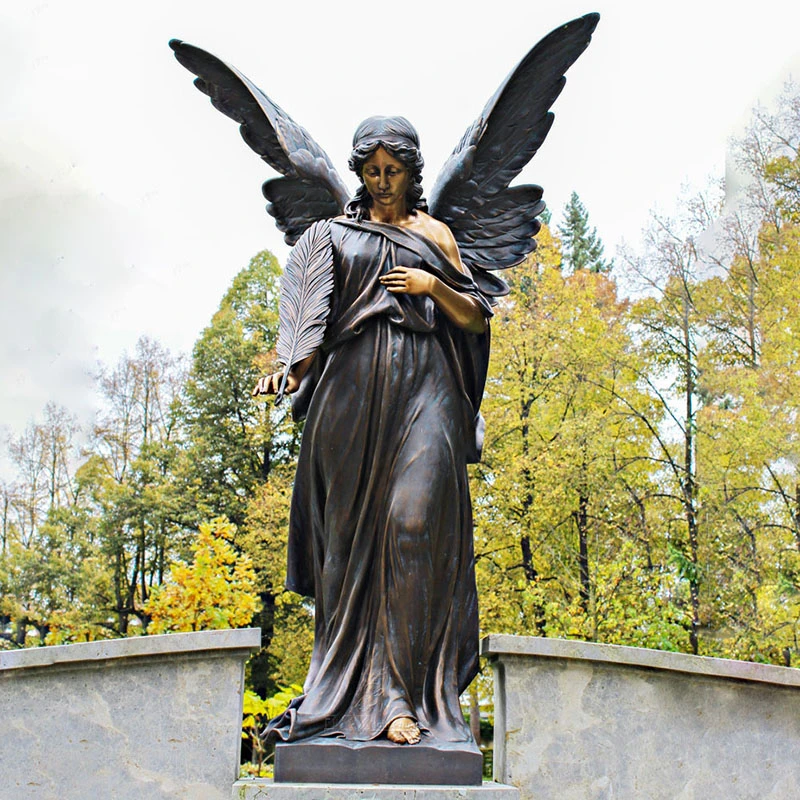lion table statue
Introduction to Advanced Bronze Sculptures In the realm of high-end decorative and architectural elements, the demand for meticulously crafted bronze artwork remains consistently high, particularly within B2B sectors such as luxury hospitality, monumental public installations, and bespoke landscape design. A prime example of such artistry is the bronze angel , a piece that combines intricate artistic expression with robust metallurgical engineering. These magnificent sculptures are not merely aesthetic additions but enduring assets, often commissioned for their symbolic significance and unparalleled longevity. This comprehensive analysis delves into the technical specifications, manufacturing processes, application scenarios, and market dynamics surrounding high-quality bronze sculptures, providing B2B decision-makers with the insights necessary for informed procurement and strategic project planning. Industry Trends and Market Dynamics in Monumental Sculpture The global market for monumental and artistic sculptures is experiencing significant growth, driven by an increased investment in public art, luxury real estate development, and the restoration of historical sites. Key trends include: Customization and Bespoke Commissions: A growing preference for unique, tailor-made pieces that reflect specific brand identities or cultural narratives. This necessitates flexible manufacturing capabilities and close client collaboration. Sustainability in Materials and Processes: While bronze is inherently recyclable, clients are increasingly scrutinizing the entire production chain for environmental responsibility, including energy consumption in casting and sourcing of raw materials. Integration of Advanced Technologies: The use of 3D scanning, CAD/CAM, and robotic fabrication in the initial stages of design and mold-making is becoming more prevalent, enhancing precision and accelerating production cycles for complex designs like a bronze angel sculpture. Demand for Durability and Low Maintenance: Especially for outdoor installations, clients seek sculptures that can withstand harsh environmental conditions with minimal upkeep, emphasizing the importance of superior material composition and expert patination. The market is projected to expand at a Compound Annual Growth Rate (CAGR) of approximately 4.5% over the next five years, indicating a robust environment for manufacturers specializing in high-quality bronze angel and similar artistic metal works (Source: Art Market Report, 2023). The Manufacturing Process of a Bronze Angel Sculpture The creation of a monumental bronze angel is a highly specialized, multi-stage process, predominantly employing the ancient yet technically refined lost-wax casting method, occasionally supplemented by modern digital fabrication techniques for initial modeling. Adherence to stringent quality control and material specifications is paramount. Materials and Standards: Typically, a high-quality art bronze alloy, such as Silicon Bronze (C87300 or C87600), is used due to its excellent fluidity for intricate details, high tensile strength (typically 350-450 MPa), and superior corrosion resistance. Chemical composition often includes Copper (Cu): 95-97%, Silicon (Si): 3-4%, Manganese (Mn): 1% max, and trace elements. All materials are sourced and tested according to ASTM B505 standards for continuous casting and ISO 9001 quality management protocols. Detailed Process Flow: Conceptualization & Digital Modeling: Initial client brief is translated into 2D sketches and then advanced 3D digital models (CAD). This stage may incorporate 3D scanning of maquettes. Maquette Creation & Enlargement: A small-scale model (maquette) is sculpted from clay or wax. For life-size or monumental pieces, the maquette is then digitally scanned or mechanically enlarged to the final dimensions using precision pantographs or CNC robotic arms, typically forming a large-scale clay or foam model. Mold Making (Flexible Silicone & Outer Plaster): A multi-piece silicone rubber mold is meticulously created directly from the full-scale model. This flexible mold captures every intricate detail. An outer plaster or fiberglass mother mold provides rigidity and support. Wax Pattern Production: Molten wax is poured into the silicone mold, allowed to cool and set, forming a hollow wax replica of the sculpture. This wax pattern is then carefully removed, cleaned, and refined by skilled artisans. Spruing and Venting: Wax "sprues" (channels for molten bronze) and "vents" (for escaping gases) are attached to the wax pattern, ensuring even metal flow and preventing air pockets. Investment Shell Creation: The sprued wax pattern is repeatedly dipped into a ceramic slurry and coated with refractory sand. This process is repeated several times, with drying periods in between, to build up a robust ceramic shell capable of withstanding extreme temperatures. Dewaxing (Burnout): The ceramic shell is placed in a high-temperature kiln (typically 800-1000°C), where the wax melts and drains out, leaving a hollow, ceramic negative impression. This gives the "lost-wax" method its name. Bronze Pouring (Casting): Molten bronze, heated to approximately 1100-1200°C in an induction furnace, is carefully poured into the pre-heated ceramic shells. Temperature control and atmospheric conditions are critical. Cooling & Breakout: After cooling, the ceramic shell is carefully broken away, revealing the rough bronze casting. Chasing & Welding: Sprues and vents are cut off. Artisans then "chase" the bronze, removing seams, imperfections, and restoring fine details using specialized tools. For large sculptures, sections are welded together using TIG welding for strength and seamless integration. Non-destructive testing (NDT) like dye penetrant or radiographic inspection may be used for weld integrity. Patination: Chemical solutions (e.g., cupric nitrate, liver of sulfur) are applied to the heated bronze surface to create specific colors and finishes (patinas). This process requires immense skill to achieve desired aesthetic effects and enhance corrosion resistance. Sealing & Finishing: A protective wax coating or clear lacquer is applied to seal the patina and provide an additional layer of environmental protection, extending the service life of the bronze angel. The service life of a properly manufactured and maintained bronze sculpture can exceed several centuries, making it an exceptional long-term investment. Technical Specifications: Life Size Bronze Statue of Archangel St Michael The Life Size Bronze Statue Of Archangel St Michael Slaying The Devil Ancient Sculpture For Sale represents the pinnacle of artistic and engineering excellence in monumental bronze work. Below are the typical specifications and performance parameters: Product Specification Table: Parameter Specification / Value Standard / Note Product Name Life Size Bronze Statue Of Archangel St Michael Slaying The Devil Ancient Sculpture For Sale SKU: FTS-ST-2309 Material High-grade Art Bronze (C87600 Silicon Bronze) ASTM B505 Compliant Height (Approx.) 250 cm (98 inches) Customizable per client specification Weight (Approx.) 280 - 320 kg (617 - 705 lbs) Varies with wall thickness and internal structure Casting Method Traditional Lost-Wax Casting Ensures intricate detail reproduction Patina Finish Multi-layered Chemical Patina (e.g., Green Verd-Antique, Dark Brown, Custom) Weather-resistant and UV stable Surface Protection Clear Lacquer or Protective Wax Coating Enhanced outdoor longevity Tensile Strength 350 - 450 MPa ASTM B505 minimums exceeded Corrosion Resistance Excellent (suitable for coastal and urban environments) Tested per ASTM B117 (Salt Spray) Installation Integrated structural armature for secure mounting Anchor bolts and base plate supplied Expected Service Life 200+ years (with proper maintenance) Historical precedent of similar bronze works Application Scenarios and Technical Advantages The enduring beauty and structural integrity of a bronze angel make it suitable for a diverse range of high-profile applications across various target industries: Target Industries: Hospitality & Resorts: Grand entrance features, garden focal points, luxury suite embellishments. Public Art & Municipal Projects: Parks, plazas, governmental buildings, memorial sites. Religious Institutions: Churches, cathedrals, sacred gardens. Private Estates & High-Net-Worth Individuals: Bespoke commissions for landscape architecture and interior design. Commercial & Corporate Campuses: Symbolic installations representing corporate values or community engagement. Technical Advantages in Typical Application Scenarios: Exceptional Corrosion Resistance: Unlike many ferrous metals, bronze forms a stable patina layer that protects against environmental degradation, making it ideal for outdoor installations, even in harsh coastal or industrial atmospheres. This significantly reduces long-term maintenance costs. Durability and Mechanical Strength: Bronze alloys possess high tensile strength and resistance to fatigue, ensuring structural integrity over centuries. This is critical for large, freestanding sculptures that must withstand wind loads, seismic activity, and potential vandalism, offering a superior alternative to less robust materials. Detail Fidelity via Lost-Wax Casting: The lost-wax process allows for the capture of extremely fine details and complex undercuts, which is crucial for the intricate drapery, anatomical features, and symbolic elements characteristic of a bronze angel or any famous sculpture. This unparalleled artistic precision ensures the sculptor's original vision is fully realized. Aesthetic Versatility through Patination: The ability to achieve a wide range of permanent patinas (e.g., rich browns, varied greens, black) through controlled chemical processes offers immense aesthetic flexibility, allowing the sculpture to complement diverse architectural styles and natural environments without compromising durability. Sustainability and Investment Value: Bronze is a highly recyclable material, aligning with modern sustainability goals. Furthermore, monumental bronze sculptures, especially those considered famous sculptures, appreciate in artistic and financial value over time, representing a sound cultural and monetary investment. For instance, in a public park setting, the corrosion resistance of a bronze angel ensures its beauty is preserved against rain, pollution, and temperature fluctuations, minimizing the need for frequent restoration. In a luxury hotel, its intricate details and commanding presence elevate the guest experience and reinforce brand prestige. Vendor Comparison for Bronze Sculpture Manufacturing Selecting the right vendor for a significant investment like a large-scale bronze sculpture is critical. Key differentiators extend beyond cost to encompass material quality, adherence to artistic vision, project management capabilities, and after-sales support. Below is a comparative overview of common vendor archetypes in the industry: Bronze Sculpture Vendor Comparison Table: Feature / Category High-End/Specialized Foundry (e.g., FirstStatue) Mid-Range Custom Fabricator Mass Production Manufacturer Artistic Detail & Fidelity Exceptional; highly skilled artisans, advanced techniques (3D scanning, lost-wax). Replicates intricate designs like a bronze angel sculpture flawlessly. Good; generally capable for most designs, but may lack the very finest detail capture for complex works. Moderate; focuses on standard designs, may simplify complex elements. Material Quality & Durability Premium grade art bronze (e.g., C87600), ISO/ASTM certified. Superior corrosion resistance, longevity. Standard art bronze alloys, generally good quality with basic certifications. Often uses lower-grade alloys or mixed metals to reduce cost, impacting long-term durability. Customization & Design Flexibility Full bespoke capabilities, from concept to installation. Unlimited design iterations, complex engineering solutions. Good for modifications to existing designs or moderately complex new designs. Limited to minor alterations of existing templates. Project Management & Communication Dedicated project managers, transparent progress reporting, expert consultation. Standard communication, may require more client oversight. Transactional; less focus on collaborative project management. Certifications & Quality Control ISO 9001, ASTM standards, detailed QC reports, material test certificates. May have basic internal QC; fewer external certifications. Minimal verifiable certifications; QC often inconsistent. Lead Time (Complex Project) 8-16 weeks for a life-size bronze angel statue, dependent on complexity. 10-20 weeks, subject to workshop load. Shorter for standard items (4-8 weeks), longer if customization is attempted. Pricing Structure Premium, reflecting material quality, artistic skill, and comprehensive service. Competitive, offering a balance of cost and quality. Cost-driven, often with hidden costs or compromises in quality. Customized Solutions for Bronze Sculptures Beyond standard offerings, the true value for B2B clients lies in bespoke solutions that align precisely with project requirements. Customization for a bronze angel or any significant sculpture can encompass several key areas: Conceptual Design & Scale Modifications: Adapting existing designs to new scales, or developing entirely new concepts from client sketches, photographs, or descriptive narratives. This includes engineering for structural integrity at larger dimensions. Material & Alloy Selection: While silicon bronze is standard, specialized alloys can be utilized for specific aesthetic or structural needs, such as marine-grade bronze for extreme coastal environments or specific historical alloy compositions for restoration projects. Unique Patina & Finish Development: Creating custom patina formulations to achieve specific color palettes or surface textures that harmonize with surrounding architecture or landscape elements. Integrated Lighting & Water Features: Designing sculptures with integrated LED lighting systems or water features (e.g., fountains, cascades) requires specialized engineering to ensure seamless operation and aesthetic integration without compromising the bronze's integrity. Base & Mounting Solutions: Custom-designed bases (e.g., granite, marble, steel, concrete) and secure mounting systems engineered for specific site conditions, including considerations for seismic zones or high traffic areas. Logistical & Installation Support: Comprehensive services including crating, international shipping, customs clearance, and on-site installation supervision by experienced technicians. Specialized foundries provide dedicated artistic and engineering teams to shepherd projects from initial concept to final installation, ensuring that every customized bronze angel statue meets the client's precise vision and all technical specifications. Application Case Studies & Customer Feedback The practical application of high-quality bronze sculptures in diverse environments showcases their versatility and long-term value. Here are examples demonstrating successful deployments: Case Study 1: Luxury Resort Entrance Feature Client: Five-Star Coastal Resort, Maldives. Requirement: A commanding, weather-resistant center-piece for the main reception area, echoing themes of tranquility and natural beauty. The client sought a piece akin to a serene bronze angel sculpture, customized to reflect indigenous motifs. Solution: A 3-meter-tall stylized bronze sculpture, inspired by a local mythological guardian figure, meticulously cast in marine-grade silicon bronze. The sculpture featured a custom "ocean-green" patina designed to deepen with age, mirroring the surrounding lagoon. Integrated, subtle LED uplighting was incorporated into the base. Outcome: The sculpture became a prominent landmark, frequently featured in guest photography and promotional materials. The resort management reported enhanced brand perception and significantly positive guest feedback, citing the artwork as a key differentiator. The engineering for salt-spray resistance proved highly effective, with minimal maintenance required after 5 years. Case Study 2: Urban Memorial Park Installation Client: Municipal Parks and Recreation Department, Major Metropolitan City, USA. Requirement: A durable, poignant memorial dedicated to local historical figures, designed to withstand heavy foot traffic and urban atmospheric pollution. The design was a classically styled human figure, representing resilience, with a desire for the quality of a famous sculpture in the world. Solution: A 4-meter-tall heroic bronze statue, cast using the lost-wax method, depicting a historical leader. Rigorous material testing ensured compliance with ANSI Z87.1 standards for impact resistance and local building codes for wind load. A robust, dark-brown protective patina was applied, chosen for its stability in polluted environments. The installation included a reinforced concrete plinth with an internal steel armature for seismic stability. Outcome: The monument has served as a revered public landmark for over a decade, attracting tourists and providing a focal point for community gatherings. Inspections reveal the bronze to be in excellent condition, with the patina gracefully maturing and requiring only routine cleaning. This project was cited as a benchmark for public art commissions by the city council. These examples underscore the critical role of expertise, material science, and comprehensive project management in delivering bronze sculptures that are not only aesthetically significant but also engineered for enduring performance in demanding B2B environments. Frequently Asked Questions (FAQ) Q: What is the typical lead time for a custom bronze angel sculpture? A: For custom, life-size or monumental sculptures, the lead time typically ranges from 8 to 16 weeks, depending on the complexity of the design, current production queue, and shipping logistics. This includes design finalization, mold-making, casting, finishing, and packaging. Expedited services may be available upon request for an additional fee. Q: What kind of warranty is offered on your bronze sculptures? A: We offer a comprehensive 10-year warranty against structural defects and material failures under normal use and recommended maintenance. This warranty covers the integrity of the bronze casting and welds. Patina stability is guaranteed for 5 years, with guidance provided for natural aging processes and re-patination services available. Q: How do you ensure the sculpture is protected during shipping? A: Each sculpture is meticulously crated in custom-built, robust wooden container111s designed for international transit. Internal foam padding, bracing, and moisture barriers are utilized to prevent movement and damage. We partner with specialized art logistics providers for secure, insured delivery worldwide. Q: What after-sales support do you provide? A: Our commitment extends beyond delivery. We offer ongoing consultation for maintenance, cleaning, and restoration. Our expert team can provide virtual or on-site support for installation queries and long-term care plans. Replacement parts (e.g., for integrated lighting) can also be supplied. Q: Can you accommodate specific engineering requirements, such as for wind resistance or seismic zones? A: Absolutely. Our engineering team specializes in designing structural armatures and mounting solutions to meet specific local building codes and environmental conditions, including high wind load areas and seismic zones. We provide detailed structural calculations and installation diagrams as part of our project deliverables. Conclusion The commissioning of a high-quality bronze sculpture, such as a monumental bronze angel, represents a strategic decision for B2B clients seeking to make an enduring statement of aesthetic value and robust engineering. From the precision of the lost-wax casting process to the meticulous application of bespoke patinas, every stage of creation is governed by stringent quality controls and artistic integrity. The inherent durability, versatile application scenarios, and potential for profound symbolic resonance position these artworks as valuable, long-term assets for luxury establishments, public spaces, and private collectors globally. By partnering with specialized foundries, clients ensure their vision is realized with unparalleled fidelity, backed by comprehensive support and a commitment to excellence. Citations ASTM International. (2023). ASTM B505 / B505M-18, Standard Specification for Copper Alloy Continuous Castings. ASTM International. International Organization for Standardization. (2015). ISO 9001:2015, Quality management systems – Requirements. ISO. National Bureau of Standards. (1982). Bronze Sculpture: An Analysis of the Art Form and Its History. National Museum of American Art. Art Market Report. (2023). Global Art Market Insights and Forecasts. UBS and Art Basel.
Custom Design
Experienced Design Team
Graphic Design, CAD, 3D, Rendering, Video, etc, all available. According to your request to design, until to get your satisfaction.
Why Better
Integrity-Our Eternal Motto
get your satisfaction. 31-Year manufacturer of production and export experience . So we give you competitive price with best quality. Large stock for you to choose from.
One- Step Solution
Sculpture projects one step solution
Inquiry - Design - Quote - Order - Product - Ship - Install - After-Sales Service
TENGYUN is professional manufacturer with indoor and outdoor
sculptures.
Customer Feedback Videos
Our original collection of 8 abstract female bronze statues— from concept design to final casting, every statue was independently created and produced by TENGYUN. Each lady sculpture showcases elegance, creativity, and emotion, reflecting the timeless beauty of bronze.With our strong production capability and dedication to craftsmanship, we bring every original design to life while respecting intellectual property. TENGYUN is committed to innovation, originality, and creating meaningful works for the modern world.
-
 Phone
Phone -
 E-mail
E-mail -
 Whatsappwhatsapp
Whatsappwhatsapp -
 Top
Top





